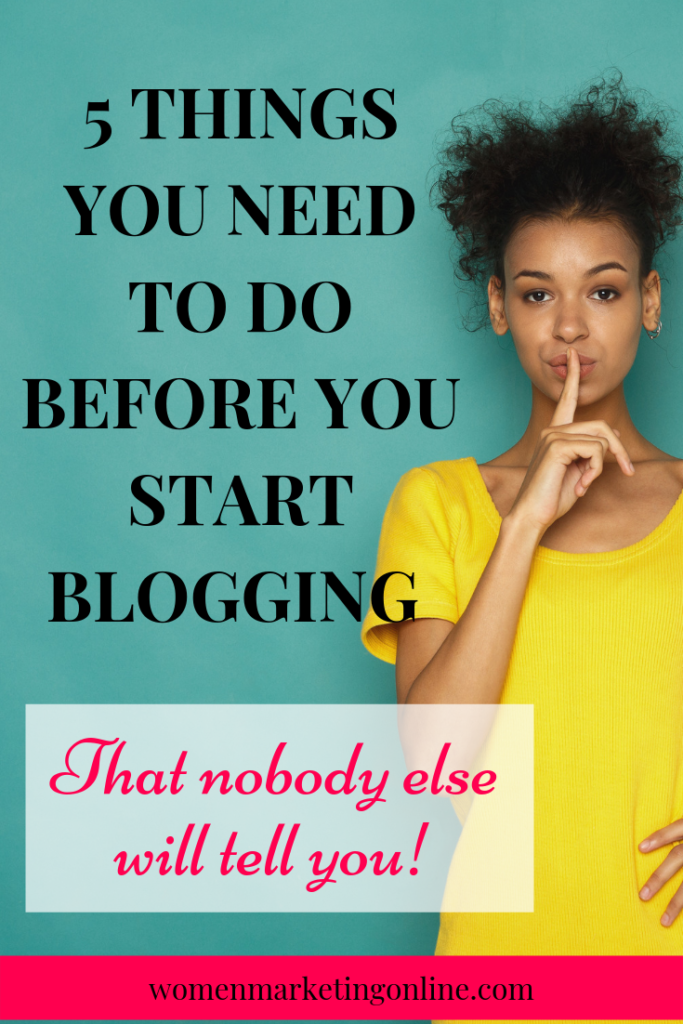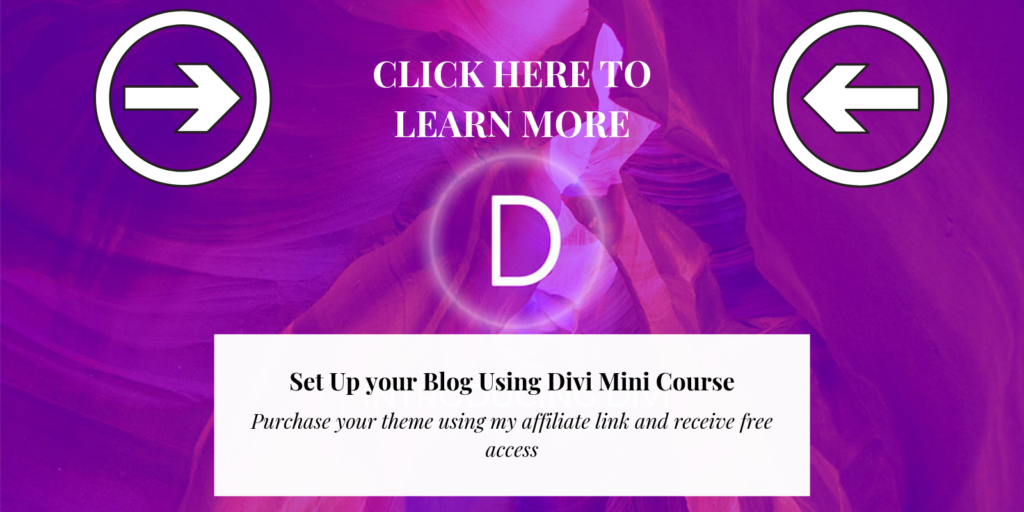This post may contain affiliate links, read the disclaimer here.
I take a lot of blogging courses (check out my blogging courses roundup), and I have learned how most bloggers approach the steps you should take before you start blogging. Some are excellent and some just OK. However, they all have a common thread: even the excellent courses don’t approach starting a blog the way I will in this post. After gaining some experience with starting a few blogs, I started adding a few steps to the process, or at least, changing the order. In this post, I share five things you need to do before you start blogging.

1- You Need to Shift your Mindset
Before you start blogging, you will need to shift your mindset in a few different ways: you will need to understand that starting a business requires some investments and that productivity is not calculated in terms of hours.
You Need to Invest in Your Business
The problem with online businesses is that they are cheap to start. Well, you might not think it’s a problem, but most people need more skin in the game to feel committed. I can’t believe how online marketers feel that a tool that cost $30 a month is too expensive! Yes, of course, the cost of all the tools can add up to a couple of hundreds of dollars a month. It’s still very inexpensive compared to the cost of brick-and-mortar businesses. If you want your blog to make you money, you have to treat it like a business. Entrepreneurs invest in their businesses, and before you start blogging, you have to start investing.
Purchase the right tools
Before you start blogging, you will need to purchase the right tools. Doing things on the cheap will cost you time and money in the end. By now, you might be thinking: People do talk about the tools you need to start blogging. It’s not something nobody will tell you. It’s a matter of perspective, blogging courses do recommend tools, but they don’t emphasize how essential the tools are.
Furthermore, they don’t explain that these tools will become a source of income. Think about it: whatever tools and products you use and love, you can share and monetize as an affiliate when your blog starts getting more traffic. Bloggers need a reality check, and they need to understand that getting the proper tools before they start blogging is necessary. It is not optional!
What tools?
These are the very basic paid tools you need:
- Host and domain: This is the land where your blog lives. I started with Bluehost with my first blog, moved on two different providers, and came back to Bluehost recently. In my opinion, Bluehost has the most user-friendly and reliable platform.
- WordPress Theme: That’s the design of your blog. There are lots of free themes to choose from, but I don’t recommend you go for a free theme. The principle that you pay for what you get, goes for Website themes just like everything else in life. I have done the free themes, and I have purchased many different themes, even the premium ones. Check out this comparison between OptimizePress and Divi, for example. My ultimate favorite is Divi. Purchase the theme using my affiliate link, and free get access to my mini-course to set up your blog pages (valued at $39).

- Email service provider: Like everyone else, I started on the cheap because I didn’t want the added monthly cost, and I got MailChimp. Even with MailChimp, I didn’t go with the free plan, I used the paid option, which comes to about $10 a month when you don’t have a lot of subscribers. Listen, your funnels are an essential part of the success you will get in your business. Effective email sequences are critical! While you can set up sequences using MailChimp, it is so much easier in ConvertKit. I highly encourage you to use ConvertKit. You will save tons of time right away while creating your sequence and in the future, because I tell you, you will end up switching!
- Landing page builder: You can build your pages in ConvertKit, and they look pretty decent, so I will give you that one if you want to hold off. I started using LeadPages (get two weeks for free with my affiliate link) very early on in my business following the advice of many trainers I follow. I have never regretted it! These landing pages look professional, and they are easy to create.
- Grammarly: As a blogger, you are going to produce a lot of content. Grammarly is essential to avoid grammar and spelling mistakes. Get the paid version, it’s totally worth it!
- Tailwind: Now, bloggers will tell you to to get Tailwind to get more traffic to your blog from Pinterest. What they won’t tell you is to wait before you get it. You should have at least 30 blog posts, and be in a position to keep posting every week before you worry about getting Tailwind. I made the mistake to purchase it almost right from the beginning with my other blog, and after about 2 months of being quite happy about my purchase, I realized I didn’t have enough blog posts to cycle through.
- Pretty Links: That is actually a free tool, but start storing all your affiliate link using this plugin right away. It will save you a lot of time and headache to have everything in one place.
Buy courses
Any profession that pays well requires an education. Blogging is no different. If you want to succeed with your blog, you are going to have to get an education. Keep in mind that most courses offer affiliate programs, so you will be able to monetize the courses that you enjoyed. My all-time favorite blogging courses is Online Business for Her by Natalie Bacon and the Pro Blogger Bundle by Create and Go.
Stop thinking in term of hours
Let me break this news to you: It doesn’t matter how many hours you “work” on your blog! What truly matters is how much you produce. As an entrepreneur, you need to ditch the dollars per hour mentality. It doesn’t matter how many hours you spent creating a product, what matters is how you market your product, and whether it sells.
2- Decide How you Will Make Money
While blogging courses do talk about monetization strategies, they don’t tell you to pick your main strategies right away. The reason I suggest you do that is it will set the direction for your whole blog. Launch your Blog, one of my favorite blogging courses, talks about not creating a paid product and not worrying about monetizing right away. I agree and disagree with that. Yes, focus on creating your freebies at first and see what is popular with your audience. Don’t create a paid product not knowing if your readers will even want to buy it. However, figure out what affiliate products you would like to promote, and start thinking about what freebies you could test to determine if you could create a paid product.
I created my freebie My 5-Step Formula to Growing your Network Marketing Business on Instagram before I had a blog. When I saw how popular it was with my audience, I know I had something that could help people. I created a paid course, which I started selling again right from Instagram before I started promoting it on my blog.
What you will you be selling?
Most people who start a blog have no idea how they are going to monetize it. If you are blogging to make money from your blog, you need always to keep that in mind. Any blog post you publish will either educate your readers about a topic that relates to your paid products or help them realize the need they have for it.
Who needs what you will be selling?
Knowing in advance what you are going to sell is going to help you choose your niche. Whatever you decided to sell is not for everyone. Spend some time thinking about who needs what you are offering. Think about how these people are going to benefit. You should even be able to come up with a few blog posts as you reflect on your products, how they can help, and who they can help.
Check out this mini-course for a deep dive in the process that will help you do that, and every other step explained in this post:
3- Create your freebie
Once you have a solid grasp on what you will be selling, how, and who needs it, you are in a position to create your freebie. Your freebie is also called a lead magnet. It’s a free resource you will be offering to entice people to sign to your mailing list.
Why you need a mailing list
A mailing list is your lifeline between you and your ideal customer. It’s a way to capture your blog visitor’s email addresses and make sure you can nurture a relationship with them.
Nobody will ever tell you to create your freebie before you start blogging, and I have often wondered why. There is no reason to miss out on the opportunity to capture your blog visitors even if you are getting very few at first. I started building my mailing list BEFORE I had a blog! I did it on Instagram. Learn how in this free training:

4- Create your email sequence
I mentioned the importance of your email sequences already. Let’s talk about that a bit further.
How to use marketing funnels in your business
Your funnels are the way you will make most of your sales. You will rarely find someone who will purchase right away straight from your Website. When you set up a proper marketing funnel, you allow your new subscribers to get to know you and to learn more about what you offer.
Give more value
When you create your email sequences, make sure that the first emails give more value. As your subscribers get to know you, they will start trusting you more. The more you help them solve their problems, the better. Share your best tips on a topic related to your freebie. Invite them to connect on social media. Tell your story.
Make a special offer
By now, you should know at least one thing you want to be selling. Now is the time to ask for the sale. Introduce your offer, give a special discount only for new subscribers (it should be time-sensitive). Write one or two emails to talk about the benefits of the products you are offering.
5- Test your freebie
Please let go of perfectionism! To create freebies and funnels that work, you will have to make a lot of them! Don’t spend more than a few days on a lead magnet.
Social media is the best way to test your freebies before you start getting a lot of blog traffic. You don’t even need that big of an audience. I started testing freebies on social media last year. When I create a new freebie, I talk about it on my Stories on Instagram. If it’s a good idea, I will get a few sign-ups. If it isn’t, I don’t get anyone. I even did this a few times before creating the actual freebie. Email challenges and courses are very effective lead magnets right now, but they require a lot of work. When I had an idea for a challenge, I would talk about it on Instagram. If people signed up, then I created the actual email sequence. If not, then, I just dropped the idea.
This blog post is already over 2,000 words, and I have so much more to share about getting Ready to Blog that I decided to create a mini-course on the topic. You can either purchase it for $49 (a ridiculous price for the value) or get if for free if you purchase Blog with a Full-Time Job using my affiliate link.

